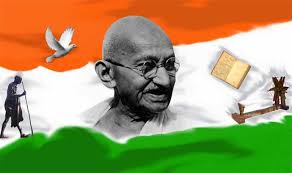Mahatma Gandhi
Born and raised in a Hindu merchant caste family in coastal Gujarat, western India, and trained in law at the Inner Temple, London, Gandhi first employed nonviolent civil disobedience as an expatriate lawyer in South Africa, in the resident Indian community's struggle for civil rights. After his return to India in 1915, he set about organising peasants, farmers, and urban labourers to protest against excessive land-tax and discrimination. Assuming leadership of the Indian National Congress in 1921, Gandhi led nationwide campaigns for easing poverty, expanding women's rights, building religious and ethnic amity, ending untouchability, but above all for achieving Swaraj or self-rule.
Gandhi famously led Indians in challenging the British-imposed salt tax with the 400 km (250 mi) Dandi Salt March in 1930, and later in calling for the British to Quit India in 1942. He was imprisoned for many years, upon many occasions, in both South Africa and India. Gandhi attempted to practise nonviolence and truth in all situations, and advocated that others do the same. He lived modestly in a self-sufficient residential community and wore the traditional Indian dhoti and shawl, woven with yarn hand-spun on a charkha. He ate simple vegetarian food, and also undertook long fasts as a means of both self-purification and social protest.
Gandhi's vision of an independent India based on religious pluralism, however, was challenged in the early 1940s by a new Muslim nationalism which was demanding a separate Muslim homeland carved out of India.[7] Eventually, in August 1947, Britain granted independence, but the British Indian Empire[7] was partitioned into two dominions, a Hindu-majority India and Muslim Pakistan.[8] As many displaced Hindus, Muslims, and Sikhs made their way to their new lands, religious violence broke out, especially in the Punjaband Bengal. Eschewing the official celebration of independence in Delhi, Gandhi visited the affected areas, attempting to provide solace. In the months following, he undertook several fasts unto death to promote religious harmony. The last of these, undertaken on 12 January 1948 at age 78,[9] also had the indirect goal of pressuring India to pay out some cash assets owed to Pakistan.[9]Some Indians thought Gandhi was too accommodating.[9][10] Nathuram Godse, a Hindu nationalist, assassinated Gandhi on 30 January 1948 by firing three bullets into his chest at point-blank range.[10]
Indians widely describe Gandhi as the father of the nation (Hindi: राष्ट्रपिता).[11][12] The title "The Father of the Nation" for Gandhi is not an official title and has not been officially accorded by Government of India. An RTI query filed by a 10-year-old girl fromLucknow in February 2012 revealed that PMO has no records of ever according such title to Gandhi. MHA and National Archives of India also communicated of not having any records. Origin of this title is traced back to a radio address (on Singapore radio) on 6 Jul 1944 by Subhash Chandra Bose where Bose addressed Gandhi as "The Father of the Nation". On 28 Apr 1947, Sarojini Naiduduring a conference also referred Gandhi as "Father of the Nation".[13][14] The RTI applicant had also pleaded for Gandhi to be officially declared as "Father of the Nation" to which the MHA informed that Gandhi cannot be accorded with the title by Government of India since the Indian constitution does not permit any titles except educational and military titles.[14]
His birthday, 2 October, is commemorated as Gandhi Jayanti, a national holiday, and world-wide as the International Day of Nonviolence.



No comments:
Post a Comment